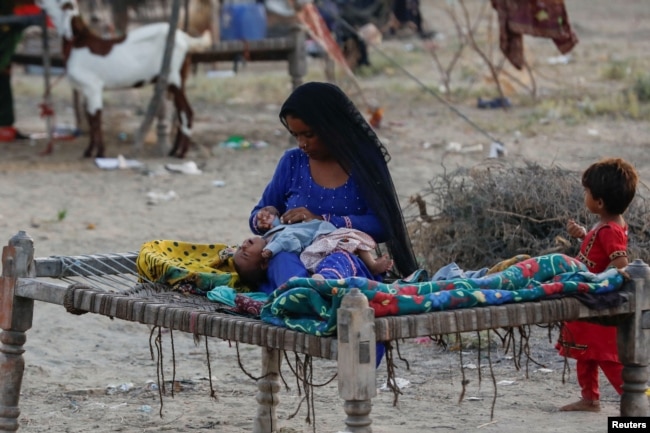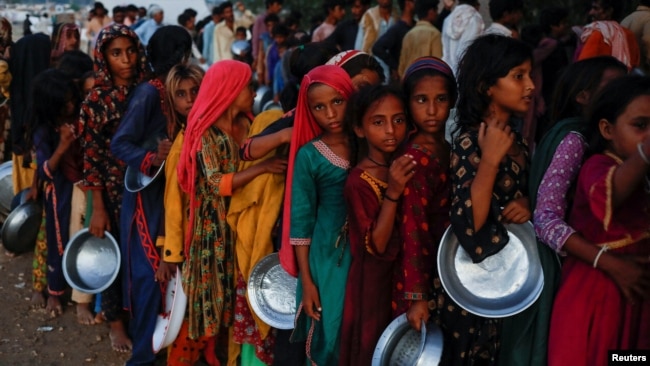洪水被害だけではありません。それによる健康被害は甚大になものでした。
これが我々に示す事の重大さを心に刻み、真剣に取り組まなければなりません。カウントダウンは始まっています!!
VOで英語を学びましょう!!
パキスタンの洪水で最も被害を受けたのは女性や子どもたち(和訳)
Women, Children Affected Most by Pakistan’s Floods
September 20,2022
パキスタンで発生した大洪水により、何万人もの人々が感染症や水を媒介とする疾病に罹患しています。農村部に住む女性や子どもは、こうした病気に特にかかりやすいと専門家は指摘しています。
洪水の水は引き始め、あるいは遠ざかりつつあります。しかし、水は2ヶ月から6ヶ月間、場所に残っている可能性があります。停滞水(Stagnant water)は、被災地に住む人々に深刻なリスクをもたらします。滞留水(Stagnant water)とは、水が流れていない状態を指します。
マラリア、デング熱、皮膚疾患などの病気が急速に広まっています。この情報は、パキスタン南部のシンド州政府による新しい報告書から得られたものです。
パキスタンのシェバズ・シュリフ首相は最近、ウズベキスタンで開かれた上海協力機構(SCO)の会合で講演しました。彼は、「滞留水が水を媒介とする病気を生んでいます。子供たちはマラリアや下痢にかかり......あらゆる種類の病気......何百万人もの人々が戸下で暮らしています。 "と述べました。
洪水は何十万人もの人々を家から追い出しています。これらの人々は今、食料、避難所、清潔な飲料水、トイレ、医薬品を切実に必要としています。
※be in desperate need of:~を心底必要としている
洪水は3,300万人に影響を与え、そのうち1,600万人は子どもたちです。そのうちの300万人以上の子どもたちが、直ちに命を救うための支援を必要としていると、国連難民機関は言います。
7月1日以降、洪水地域に設置された仮設医療センターでは、230万人の治療が行われました。
パキスタンの国家災害管理局によると、これまでに子ども536人、女性308人を含む1,508人が死亡しています。
アブドゥラ・ファディル氏は、国連児童基金(ユニセフ)のパキスタン代表です。彼は声明で、「私はこの2日間、洪水の被災地に滞在しています。家族の状況は暗澹たるものであり、私が聞いた話は絶望的なものでした」と述べました。
ファディル氏は、栄養失調(malnourished)の子供や、下痢やマラリアなどの病気にかかった母親を見たことを確認しました。
今回の洪水は100年に一度と言われています。先週、科学者たちは、気候変動によってより深刻になった可能性が高いと述べています。
パキスタン南部で降った異常な季節性雨と、北部での気候変動による氷河の融解が重なり、大規模な洪水が発生したのです。
今年のパキスタンのモンスーンシーズンは、例年より早く始まり、遅く終わりました。モンスーンの期間中、同国には391ミリメートルの雨が降りました。これは30年間の平均値より190パーセントも多い雨量です。
Women, Children Affected Most by Pakistan’s Floods
Severe flooding in Pakistan has left tens of thousands of people sick with infectious and water-borne diseases. Women and children in rural areas are especially vulnerable to such diseases, experts say.
Flood waters have begun to recede, or move away. But water may remain in places for two to six months. Stagnant water presents a serious risk to people living in the affected areas. Stagnant means water that is not flowing.
Diseases such as malaria, dengue fever and skin problems are spreading quickly. That information comes from a new report by the government of Pakistan’s southern Sindh province.
Pakistani Prime Minister Shehbaz Shrif recently spoke at a Shanghai Cooperation Organization (SCO) meeting in Uzebekistan. He said, “Stagnant water is giving rise to the water-borne diseases. Children getting malaria and diarrhea ... all kinds of diseases…millions of people are living under open sky.”
The floods have forced hundreds of thousands of people from their homes. Those people are now in desperate need of food, shelter, clean drinking water, toilets and medicine.
The flooding has affected 33 million people, 16 million of which are children. Over 3 million of those children need immediate life-saving support, the United Nations refugee agency says.
Since July 1, temporary medical centers set up in the flooded region have treated 2.3 million people.
There have been 1,508 deaths so far, including 536 children and 308 women, according to Pakistan’s National Disaster Management Authority.
Abdullah Fadil is a United Nations Children’s Fund (UNICEF) Representative in Pakistan. He said in a statement, “I have been in the flood-affected areas for the past two days. The situation for families is beyond bleak, and the stories I heard paint a desperate picture.”
Fadil confirmed that he had seen malnourished children and mothers with the diseases like diarrhea and malaria.
The flooding is considered a once-in-a-century event. It was likely made more severe by climate change, scientists said last week.
Extreme seasonal rains in the southern areas of Pakistan, combined with glacial melt caused by climate change in the northern areas, created the massive flooding.
Pakistan’s monsoon season this year started earlier than usual and ended later than usual. The country received 391 millimeters of rain during the monsoon period. That is 190 percent more than the 30-year average.
Words in This Story
vulnerable – adj. able to be hurt or at risk of being harmed
malnourished – adj. not eating enough food or not eating enough healthy food; poorly nourished
toilet – n. a large bowl attached to a pipe that is used for getting rid of bodily waste and then flushed with water
diarrhea - an illness that causes you to pass waste from your body very frequently and in liquid rather than solid form
glacial – adj. related to glaciers: frozen rivers of ice on mountains and in Arctic areas
bleak —adj. not hopeful or encouraging
monsoon– n. the rainy season in South and Southeast Asia

